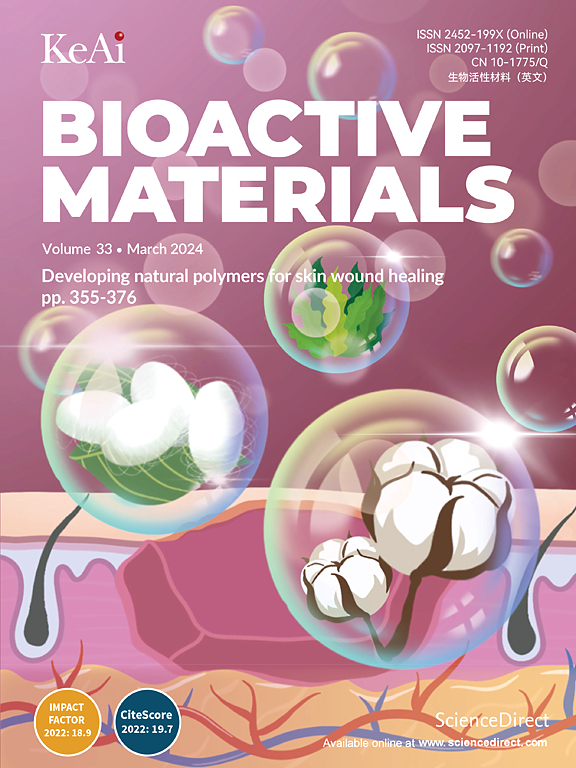Transcutaneous electrotherapy of facial nerve injuries based on dissolvable conductive microneedles
IF 18
1区 医学
Q1 ENGINEERING, BIOMEDICAL
引用次数: 0
Abstract
Local electrical stimulation (LES) is a widely used clinical method to treat peripheral nerve injury. However, existing plate electrodes (PE) usually suffer from low electronic transport efficiency, whereas acupuncture electrical stimulation may cause damage to normal tissues. There is an urgent need to develop an innovative LES technique with efficient electronic transport, minimal tissue injury and enhanced biosafety. Here, we present a new stretchable transcutaneous electrical stimulation system (STESS) that integrates dissolvable conductive microneedles (DCMN) for optimal skin penetration and electronic transport, along with snake-like electrodes that offer superior flexibility, which can effectively penetrate the stratum corneum, enabling deep tissue electrostimulation with minimal injury. In vitro studies and 3D finite-element analysis demonstrate that the DCMN-based electrotherapy significantly enhances subcutaneous nerve stimulation compared to the conventional PE-based technique. By diminishing the electrical resistance of the stratum corneum, the DCMN-based electrotherapy has shown remarkable in vivo therapeutic efficacy in a rat facial nerve crush injury model. This will pave the way for innovative physiotherapeutic methodologies in the realm of neurological rehabilitation.

基于可溶导电微针的面神经损伤经皮电疗
局部电刺激(LES)是临床上广泛应用的治疗周围神经损伤的方法。然而,现有的平板电极(PE)通常存在电子传递效率低的问题,而针刺电刺激可能对正常组织造成损伤。迫切需要开发一种具有高效电子传输、最小组织损伤和增强生物安全性的创新LES技术。在这里,我们提出了一种新的可拉伸经皮电刺激系统(ess),该系统集成了可溶解导电微针(DCMN),可实现最佳的皮肤穿透和电子传输,以及具有优越灵活性的蛇形电极,可以有效地穿透角质层,实现深层组织电刺激,且损伤最小。体外研究和三维有限元分析表明,与传统的基于pe的电疗法相比,基于dccn的电疗法显著增强了皮下神经刺激。通过降低角质层的电阻,dcmn电疗法在大鼠面神经挤压损伤模型中显示出显著的体内治疗效果。这将为神经康复领域的创新物理治疗方法铺平道路。
本文章由计算机程序翻译,如有差异,请以英文原文为准。
求助全文
约1分钟内获得全文
求助全文
来源期刊

Bioactive Materials
Biochemistry, Genetics and Molecular Biology-Biotechnology
CiteScore
28.00
自引率
6.30%
发文量
436
审稿时长
20 days
期刊介绍:
Bioactive Materials is a peer-reviewed research publication that focuses on advancements in bioactive materials. The journal accepts research papers, reviews, and rapid communications in the field of next-generation biomaterials that interact with cells, tissues, and organs in various living organisms.
The primary goal of Bioactive Materials is to promote the science and engineering of biomaterials that exhibit adaptiveness to the biological environment. These materials are specifically designed to stimulate or direct appropriate cell and tissue responses or regulate interactions with microorganisms.
The journal covers a wide range of bioactive materials, including those that are engineered or designed in terms of their physical form (e.g. particulate, fiber), topology (e.g. porosity, surface roughness), or dimensions (ranging from macro to nano-scales). Contributions are sought from the following categories of bioactive materials:
Bioactive metals and alloys
Bioactive inorganics: ceramics, glasses, and carbon-based materials
Bioactive polymers and gels
Bioactive materials derived from natural sources
Bioactive composites
These materials find applications in human and veterinary medicine, such as implants, tissue engineering scaffolds, cell/drug/gene carriers, as well as imaging and sensing devices.
 求助内容:
求助内容: 应助结果提醒方式:
应助结果提醒方式:


